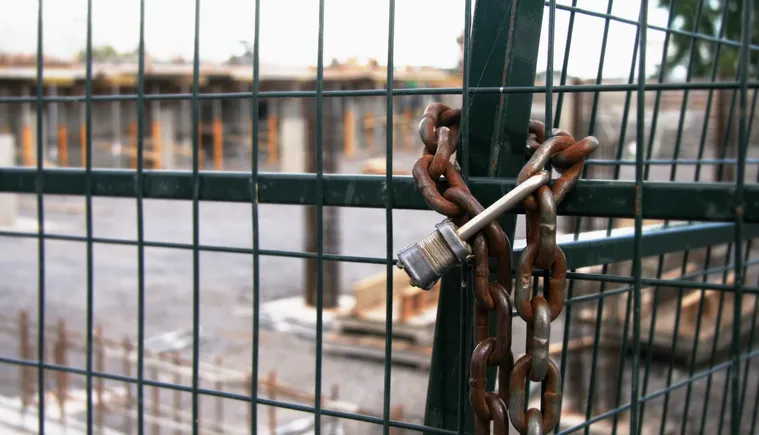Dan Rosenberg is a construction attorney at law firm Much Shelist, where he supports clients in construction, design, real estate and insurance matters. Prior to that, Rosenberg was the general counsel for Chicago-based construction firm McHugh Enterprises. Opinions are the author’s own.
In a previous piece, I focused on red flags for when an owner may be in financial distress. But money troubles affect multiple stakeholders, including contractors of all kinds. In some sectors, I have continued to see increasing signs of financial strain on contractors and especially trade contractors.
High interest rates and a slowdown of work in certain sectors seem to be the particular causes of strain.

Dan Rosenberg
Permission granted by Much Shelist
But, before an entity fails entirely, there are usually signs. Below are a list of signs that indicate prime and trade contractors may be in distress — red or yellow flags that should cause concern or at least create heightened awareness for other partners. These become increasingly concerning, of course, when there are more than one appearing on a project.
Signs a contractor could be in distress
When general contractors, trade contractors or suppliers are in financial distress, the indicators are often similar to those of troubled owners, such as media headlines, slowdowns in payment and significant personal changes. Additional red flags include:
Labor disruptions. If a contractor’s labor force suddenly is not showing up to the jobsite, and it is not the result of some other dispute on the project, this is a bad sign. A major red flag is if onsite labor is not paid by a contractor. It is also bad if a trade contractor’s crew size decreases in unanticipated ways.
Unplanned removal of equipment. If a trade contractor starts removing its equipment for unexplained or unplanned reasons, this should be a cause for concern.
Sudden decrease in the quality of work. If a trade contractor’s work suddenly declines in quality for unexplained reasons, this could be a sign of distress. Similarly, a stoppage in deliveries can signify the contractor is not paying its suppliers or that the contractor is only paying essential suppliers.
Liens. A major concern is if lower-tier subcontractors or suppliers start to record liens due to non-payment. One lien or a related lien involving a dispute between two parties may not be a concern, but when there are unrelated or multiple liens recorded, this is a bad sign.
Union notification or warnings. In union markets, labor is compensated in two ways: the wages paid directly to employees and the benefit contribution (pension, health insurance, etc.) paid by the employer to multi-employer union funds. Distressed contractors often treat the union funds as “lenders of last resort.”
If the union funds are not paid by an employer, the fund has a legal obligation to pursue payment, including by liening the project. Warnings of unpaid benefit contributions are never a good sign. It is worth noting that most unions will notify a general contractor regarding whether or not a trade contractor, for example, has made its required payments.
Account debtor default letters. In many instances, lenders providing lines of credit to a contractor are secured by the contractor’s receivables. When a borrower defaults on its loans, such lenders can issue letters demanding that all receivables be paid directly to the lender. Such letters, also sometimes referred to as “UCC Account Debtor Letters,” are usually a sign that a business is in significant financial trouble.
What to do
If you see signs that a party with whom you are working is possibly in financial distress, besides contacting able legal counsel, there are steps you can take to put yourself in the best position to minimize the financial harm that could impact your business. Here are some key considerations businesses can take to protect themselves.
Understand right to terminate and when to terminate. If a general contractor is not performing, try to understand why, but ultimately if the general contractor is not performing, termination may be the only option. The construction contract governs whether the general contractor (or trade contractor) can be terminated and, if so, what requirements must be met before termination.
Additionally, tactically there may be value in terminating before the general contractor (or trade contractor) files for bankruptcy, because once a party files for bankruptcy, whether you can terminate the construction contract will require authorization from the court.
Understand right to supplement. If the general contractor or trade contractor suddenly is not keeping up with your schedule or is not able to obtain certain equipment or materials it owes, the owner or general contractor may need to supplement the problematic trade contractor. Again, the rights surrounding such supplementation are governed by the contract in place.
Understand right to direct pay. Joint payment or direct payments to those below a distressed general contractor or trade contractor are important. The right to make such payments can help keep the job going. Again, this right is governed by the contract between the parties.
Consider notice and claims to bonds or subcontractor default insurance carriers. Most experienced general contractors have risk management protections in place to protect against a trade contractor failing. The most common forms of protection are trade contractor bonds or subcontractor default insurance.
If a trade contractor is in distress, such bonds or insurance offer significant protection. It is important to timely provide notice to the surety or insurer and to take the steps necessary to preserve the claim.
As 2024 continues, be on the lookout for contractors or projects that are faltering and use these tips to protect yourself if it happens.
Much Shelist principals Scott R. Fradin and Robert Glantz contributed to this story.
